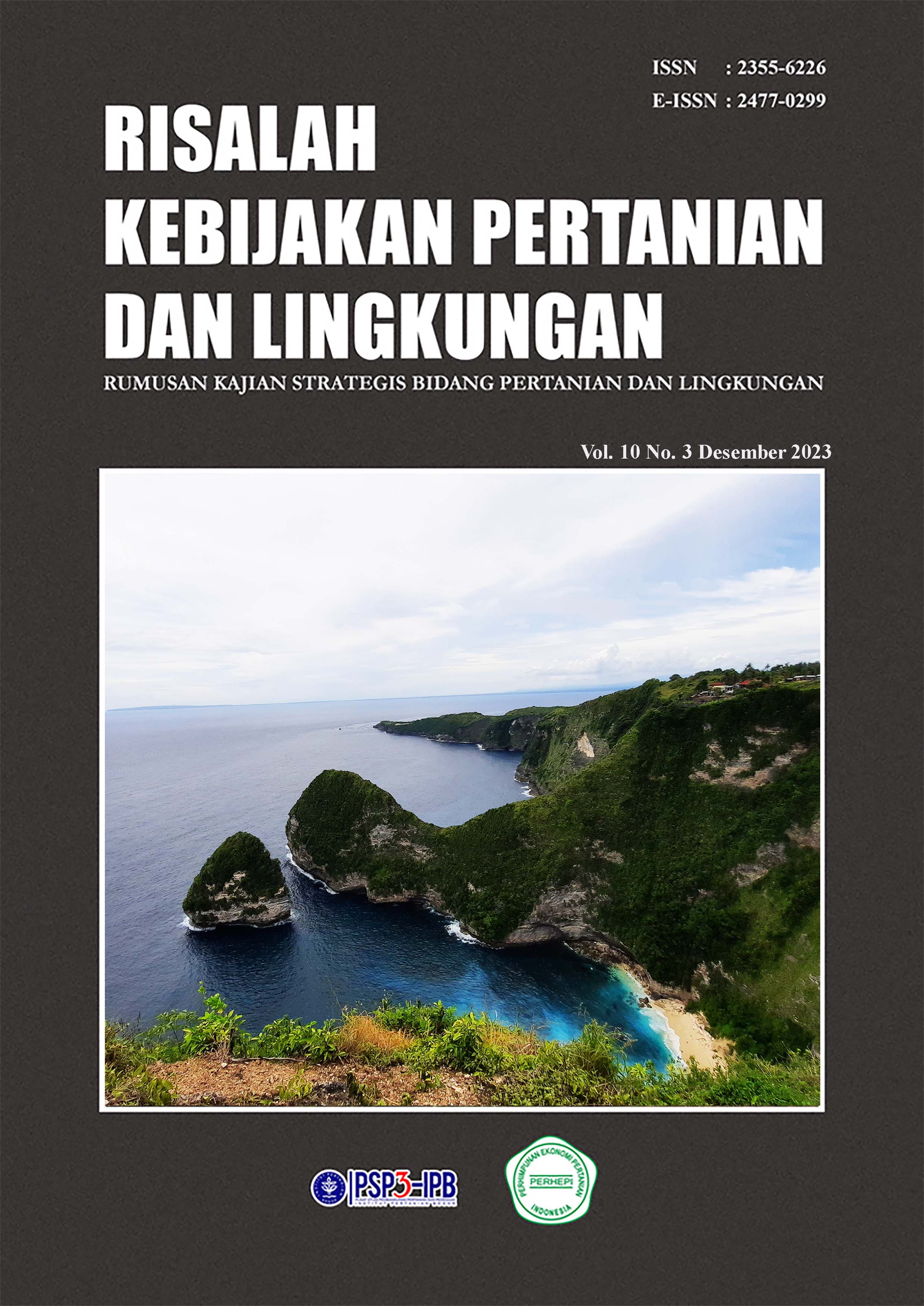EMISI ENERGI DAN KEBIJAKAN KENDARAAN LISTRIK: STUDI KOMPARASI ANTARA CHINA DAN INDONESIA
Abstrak
Negara China dan Indonesia termasuk negara dengan populasi besar dan penyumbang emisi karbon dioksida dunia. Salah satu langkah untuk mengurangi emisi melalui adopsi kebijakan kendaraan listrik. Tingkat penetrasi kendaraan listrik di China dan Indonesia dapat berbeda karena pendekatan kebijakan yang digunakan. Dalam penelitian ini, metode analisis yang digunakan adalah studi komparasi bilateral dengan tinjauan pustaka. Berdasarkan hasil analisis, negara China telah mengadopsi kebijakan kendaraan listrik sejak tahun 2001 yang disertai dengan program dan insentif berkelanjutan. Sedangkan, Indonesia baru berfokus pada kendaraan listrik, khususnya kendaraan bermotor listrik berbasis baterai sejak tahun 2019. Melalui pendekatan pasar (permintaan dan penawaran) serta pendekatan infrastruktur diperoleh kondisi kebijakan di China dan Indonesia yang berbeda, serta dapat digunakan sebagai tolak ukur pengambilan keputusan bagi pemerintah Indonesia. Implikasi kebijakan dari hasil analisis, yaitu peningkatan insentif moneter dan non moneter bagi produsen serta konsumen, peningkatan partisipasi pemerintah daerah, dan memperjelas langkah eksekusi peta jalan kendaraan listrik Indonesia.
##plugins.generic.paperbuzz.metrics##
Unduh
Referensi
Alqodri, M.I., Widyastutik. 2023. Low emission policies of G20 member countries and export performance of indonesian motor vehicles. Jurnal Ekonomi dan Kebijakan Pembangunan, 12(1), 41-68. https://doi.org/10.29244/jekp.12.1.2023.41-68.
Chen, Z., Fan, Z., Zhao, X. 2022. Toward supply side incentive: The impact of government schemes on a vehicle manufacturer's adoption of electric vehicles. International Transactions in Operational Research, 29(6), 3565-3591. https://doi.org/10.1111/itor.13133.
Crippa, M., Guizzardi, D., Solazzo, E., Muntean, M., Schaaf, E., Monforti-Ferrario, F., Banja, M., Olivier, J.G.J., Grassi, G., Rossi, S., Vignati, E. 2021. GHG Emissions of All World Countries-2021 Report. Luxembourg: Publications Office of the European Union.
[Gaikindo] Gabungan Industri Kendaraan Bermotor Indonesia. 2022. Mobil Listrik di RI Terjual 2.803 Unit, Wuling Air ev Paling Laris. https://www.gaikindo.or.id/mobil-listrik-di-ri-terjual-2-803-unit-wuling-air-ev-paling-laris/
He, J., Yin, W. 2021. Policy Analysis of China’s New Energy Vehicle Industry Policy. Dalam Appolloni, A., Caracciolo, F., Ding, Z., Gogas, P., Huang, G., Nartea, G., Ngo, T., Striełkowski, W.Proceedings of the 2021 3rd International Conference on Economic Management and Cultural Industry (ICEMCI 2021) (hlm. 3247-3252). Atlantis Press International B.V.
Huang, Y., Chen, Y. 2017. The Review of Technology Industry Policy about New Energy Vehicles in China since the New Century. Dalam Chan et al. Proceedings of the Advances in Materials, Machinery, Electrical Engineering (AMMEE 2017) (hlm. 616-623). Atlantis Press.
Hwang, S.K. 2015. Comparative study on electric vehicle policies between Korea and EU Countries. World Electric Vehicle Journal, 7(4), 692-702. https://doi.org/10.1088/1755-1315/927/1/012003.
[IEA] International Energy Agency. 2021. Share of low-carbon sources and coal in world electricity generation, 1971-2021.
[IEA] International Energy Agency. 2022a. Enhancing Indonesia’s Power System. https://www.iea.org/reports/enhancing-indonesias-power-system.
[IEA] International Energy Agency. 2022b. Global EV Outlook 2022. https://www.iea.org/reports/global-ev-outlook-2022.
Levay, P.Z., Drossinos, Y., Thiel, C. 2017. The effect of fiscal incentives on market penetration of electric vehicles: A pairwise comparison of total cost of ownership. Energy Policy, 105, 524-533. https://doi.org/10.1016/j.enpol.2017.02.054.
Li, W., Ruyin, L., Hong, C., Feiyu, C., Xiao, Z., Muyi, Y. 2019. Effect of policy incentives on the uptake of electric vehicles in China. Sustainability, 11(12), 3323. https://doi.org/10.3390/su11123323.
Mock, P., Yang, Z. 2014. Driving Electrification: A Global Comparison Of Fiscal Incentive Policy For Electric Vehicles. Washington: International Council on Clean Transportation.
[NBS] National Bureau of Statistics of China. 2022. Statistical Bulletin of the National Economic and Social Development of the People's Republic of China in 2022.
Nugroho, S.B., Zusman, E., Nakano, R., Takahashi, K., Koakutsu, K., Kaswanto, R.L., Arifin, N., Munandar, A., Arifin, H.S., Muchtar, M., Gomi, K. 2017a. The effect of prepaid electricity system on household energy consumption–the case of Bogor, Indonesia. Procedia Engineering, 198: 642-653. https://doi.org/10.1016/j.proeng.2017.07.117.
Nugroho, S.B., Zusman, E., Nakano, R., Takahashi, K., Kaswanto, R.L., Arifin, H.S., Arifin, N., Munandar, A., Muchtar, M., Gomi, K., Fujita, T. 2017b. Exploring influential factors on transition process of vehicle ownership in developing asian city, a case study in Bogor City Indonesia. IEEE 20th International Conference on Intelligent Transportation Systems (ITSC), 674-679. https://doi.org/10.1109/ITSC.2017.8317966.
Onofrei, M., Vatamanu, A.F., Cigu, E. 2022. The relationship between economic growth and CO2 Emissions in EU Countries: A cointegration analysis. Frontiers in Environmental Science 10. https://doi.org/10.3389/fenvs.2022.934885.
Palmer, K., Tate, J.E., Wadud, Z., Nellthorp, J. 2018. Total cost of ownership and market share for hybrid and electric vehicles in the UK, US and Japan. Applied Energy, 209, 108-119. https://doi.org/10.1016/j.apenergy.2017.10.089.
Setiawan, I.C. 2019. Policy simulation of electricity-based vehicle utilization in Indonesia. Automotive Experiences, 2(1), 1-8. https://doi.org/10.31603/ae.v2i1.2020.
Simbolon, A.M., Rusli, B., Candardewini. 2022. Kebijakan kendaraan listrik dalam perspektif pasar dan infrastruktur: studi reviu komparasi bilateral Korea Selatan dan Indonesia. Jurnal Penelitian Transportasi Darat, 24(2), 83-91. https://doi.org/10.25104/jptd.v24i2.1943.
Spentzas, C.N. 1993. Towards an electric vehicle policy. International Journal of Vehicle Design, 14(23), 118-123. https://doi.org/10.1504/IJVD.1993.061828.
Risyani, I., Bahtiar, R. 2022. Estimasi nilai pajak emisi kendaraan angkutan kota di Kota Bogor. Risalah Kebijakan Pertanian dan Lingkungan, 9(3), 161-176. https://doi.org/10.29244/jkebijakan.v9i3.34830.
Wang, D., Li, Y. 2022. Measuring the policy effectiveness of China’s new-energy vehicle industry and its differential impact on supply and demand markets. Sustainability, 14(13), 8215. https://doi.org/10.3390/ su14138215.
Wang, G. Zhu, Q. 2022. Wuling Hongguang MINIEV: A New Breed of Chinese Automaker. Harvard Business School Publishing.
Xue, C., Huaguo, Z., Qunqi, W., Xueying, W., Xingbo, X. 2021. Impact of incentive policies and other socio-economic factors on electric vehicle market share: A panel data analysis from the 20 countries. Sustainability, 13(5), 2928. https://doi.org/10.3390/su13052928.
Yao, X., Ma, S., Bai, Y., Ning J. 2022. When are new energy vehicle incentives effective? Empirical evidence from 88 pilot cities in China. Transportation Research Part A: Policy and Practice, 165: 207-224. https://doi.org/10.1016/j.tra.2022.09.003.
##submission.copyrightStatement##
##submission.license.cc.by4.footer##PUBLICATION ETHICS
Jurnal Risalah Kebijakan Pembangunan Pertanian dan Lingkungan (JRKPL) is a peer-reviewed journal publishing original research to develop a coherent and respected network of landscape architecture knowledge. JRKPL committed to upholding the highest standards of publication ethics that clarifies ethical behavior of all parties involved in publishing a scientific article in JRKPL.
As publisher of JRKPL, PSP3-LPPM IPB and PERHEPI takes its duties of guardianship all stages of publishing process and we recognize our ethical and other responsibilities.
Duties of Authors
An author should not publish manuscripts describing essentially the same research in more than one journal or primary publication. Submitting the same manuscript to more than one journal is unacceptable and constitutes unethical publishing behavior. In general, an author should not submit for consideration in another journal a previously published paper.
Authorship should be limited to those who have made a significant contribution to the manuscript and should be listed as co-authors. Where there are others who have participated in certain substantive aspects of the research project, they should be acknowledged as contributors. The corresponding author should ensure that all co-authors have seen and approved the final version of the paper and have agreed to its submission for publication.
The authors should ensure that they have written entirely original works, and if the authors have used the work and/or words of others, that this has been appropriately cited or quoted. Plagiarism are include passing off another paper as the author own paper, copying or paraphrasing substantial parts of another paper (without attribution) and claiming results from research conducted by others. Plagiarism constitutes unethical publishing behavior and is unacceptable. Plagiarism detected works will be banned for further publication procedure.
The authors acknowledge that they have disclosed all and any actual or potential conflicts of interest with their work or partial benefits associated with it. All sources of financial support for the project should be disclosed. Potential conflicts of interest should be disclosed at the earliest stage possible.
Duties of the Editorial Board
Review Process
JRKPL is committed to objective and fair double-blind peer-review to prevent any actual or potential conflict of interests between the editorial and review personnel and the reviewed material. JRKPL chooses reviewers based on their expertise (whose most closely matches the topic of the paper). At least 2 reviewers are invited to evaluate a manuscript. In cases of controversy or disagreement regarding the merits of the work, an additional review will be solicited. The JRKPL editor mediates all interaction between authors and reviewers, and the review results owned by JRKPL.
Publication Decisions
The editor of a peer-reviewed JRKPL is responsible for deciding which of the articles submitted to the journal should be published. The validation of the work in question and its importance to researchers and readers must always drive such decisions. The final decision on article acceptance based on reviewer's opinions, suggestions, and comments. The editor may confer with other editors or reviewers in making this decision.
Fair Play
JRKPL evaluates manuscripts only based on the intellectual content. No race, gender, sexual orientation, religious belief, ethnic origin, citizenship, or political philosophies of the authors are considered in the evaluation process.
Confidentiality
JRKPL assure the confidentially of the manuscripts, actors, and other related information on the publishing process. Only corresponding author, reviewers, potential reviewers, other editorial advisers, and the publisher are allows for the information.
Disclosure
Unpublished materials disclosed in a submitted manuscript must not be used in an editor's own research without the express written consent of the author. Privileged information or ideas obtained through peer review must be kept confidential and not used for personal advantage.
Duties of reviewers
(1) Objectivity: Reviewer should provide written and unbiased feedback to the authors, personal criticism of the author is inappropriate. Reviewer comments should be clearly with supporting arguments indicating whether the writing is concise and relevant
(2) Expertise: Reviewer who feels unqualified to review the research reported in a manuscript or knows that its prompt review will be impossible should notify the editor and excuse himself from the review process.
(3) Acknowledgement of sources: Reviewer suggest relevant published work that has not been cited by the authors to improve the quality of the manuscript,
(4) Confidentiality: Reviewer should maintain the confidentiality of the review process. Privileged information or ideas obtained through peer review must be kept confidential and not used for personal advantage.
(5) Disclosure and conflict of interest: Unpublished materials disclosed in a submitted manuscript must not be used in a reviewer own research without the express written consent of the author. Reviewers should not consider manuscripts in which they have conflicts of interest resulting from competitive, collaborative, or other relationships or connections with any of the authors, companies, or institutions connected to the papers.























